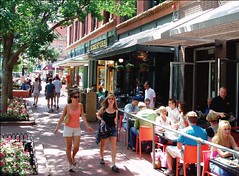Smart Growth vs. Smartest Growth: the right kind of density
From "Smart growth must become more demanding, more community-oriented, and greener (literally)" by Kaid Benfield in NRDC's Switchboard blog:
The right kind of density
We in the smart growth movement need to become much more discriminating in what we support and what we don't. In particular, we must stop applauding density per se and start advocating what my friend David Crossley, president and founder of the great organization Houston Tomorrow, calls the right kind of density - a built landscape that respects and improves upon its neighborhood instead of overpowering it.
I have the same issue with the "smart growth" movement. Many of the proponents, especially in the DC region, don't appear to have much concern about how it works on the ground, how it looks, and some tough issues concerning management, integration of civic assets and civic participation.Kaid quotes Neal Payton (who used to be based out here), writing:
I would argue that TOD should not be the end in itself, but a means to an end. Imagine great public spaces where opportunities to sustain public life become numerous. Then focus on great sidewalks, an integral part of great streets, which in turn are the major constituent of public space. As the most intimate of public spaces inhabited by individuals, sidewalks are where we have our most visceral experiences of the city. TOD represents not only an opportunity to put density near transit, but possibly as importantly, to remake the public realm creating a city of great streets and great sidewalks.
I say something similar to this all the time, that we should scrap the use of the term "TOD" especially since most people think that TOD means huge profits for and giveaways to developers, and discuss how TOD and compact development extends the qualities of livability that we want in our neighborhoods and city districts. More residents in compact spatial patterns means we use our land and transportation resources better, we have more residents paying taxes supporting the rest of the city, more residents on the streets helping making places safer, more residents able to shop locally and therefore able to support local business, more residents riding transit, allowing transit to run more frequently, more residents committed to urban living and hopefully participating in local civic affairs, etc.
Kaid writes:
Payton goes on to argue for building a rich pedestrian experience and "a robust mix of uses and price points." Perhaps most important, he eschews a building-by-building approach to design in favor of a neighborhood approach that produces a varied streetscape and landscape.
I think we should be satisfied with no less, and we should speak out when development proposals deliver less. In fact, I would go further and argue that we should also insist on affordable housing, green building, green infrastructure, and useable public park space as part of any large-scale development.
Yes.
So often I get dissed in conversations with other fellow travellers, because I am known for advocating the hard core position, one that demands excellence, and is focused on absolute rather than relative improvement. Often the response I get is "don't let the perfect be the enemy of the good."
Too often, good is just marginally better than what we are doing now. Let's demand excellence.
These are decisions that will have impact for generations, will last beyond us. So as stewards of the built and natural environment that has been left to us, which in turn we leave to the people who come after us, it's fundamental that we don't settle for mediocrity.
(I prefer to use terms like compact development or sustainable land use and resource planning over "smart growth" or even "new urbanism" because frequently these terms have become bastardized, seized by marketers to sell a "product," and have otherwise lost their meaning.)
Labels: compact development, sustainable land use and resource planning, transit oriented development




1 Comments:
Book Mumbai to Mahabaleshwar Cabs Online at cabs2go Car Rentals. Trust cabs2go for the Best
mumbai to Mahabaleshwar taxi Services.
Post a Comment
<< Home